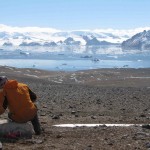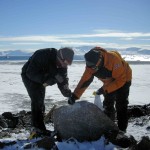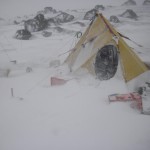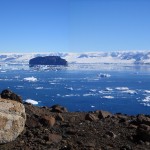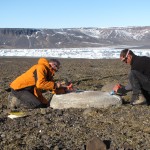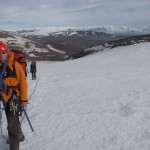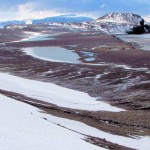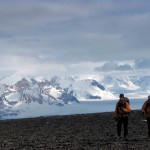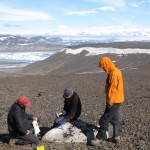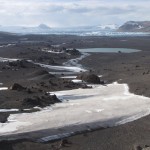Please see the following work:
Download the Glasser et al. 2014 Preprint. The following is a shorter, simpler version of the paper.
Reconstructing ice stream changes in Antarctica | Why study ancient, long-gone ice streams? | Prince Gustav Ice Stream | Living on James Ross Island | What did we find? | Dynamic ice-sheet change | Further reading | References | Comments |
Reconstructing ice stream changes in Antarctica
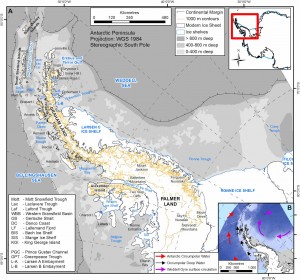
Antarctica is an area that is changing very rapidly. Ice streams are thinning, receding and shrinking. How will these ice streams change in the future?
If we want to understand this, we must look to the past; specifically, to another recent period of rapid climatic change. The Last Glacial-Interglacial Transition, a time of rapid warming not dissimilar to the present day, is particularly relevant.
Our work from James Ross Island, northern Antarctic Peninsula, reveals how the Antarctic Peninsula Ice Sheet changed during the Last Glacial-Interglacial Tranistion, from a thicker, cold, slow-moving ice sheet at around 18,000 years ago to a thinner, warmer, more dynamic ice sheet drained by fast-flowing ice streams after 12,000 years ago.
Why study ancient, long-gone ice streams?

Ice streams around Antarctica are undergoing rapid change. In recent centuries, the Siple Coast ice streams have had rapid and dynamic fluctuations in flow, including stopping flowing, whilst Pine Island Glacier is currently accelerating, thinning and receding. Predicting the wider future response of the Antarctic Ice Sheet to change requires a detailed understanding of the ice streams that dominate its dynamics.
We know that, at the Last Glacial Maximum (about 18,000 years ago), the Antarctic Peninsula Ice Sheet was drained by ice streams (see map to the right). Much of our evidence of these ice streams comes from the marine geological record; from swath bathymetry images of the sea floor, providing images of moraines and mega-scale glacial lineations, and from radiocarbon ages from microfossils from marine muds. However, these data provide only a snapshot of ice-stream behaviour during deglaciation, and don’t provide information on ice-stream initiation and dynamics.
Prince Gustav Ice Stream
In order to understand how ice streams begin, we must look to the terrestrial record. A three-person team (Neil Glasser, Bethan Davies and Jonathan Carrivick) therefore spent seven weeks on Ulu Peninsula, James Ross Island, on the Antarctic Peninsula, camping in a tiny tent, carrying around huge sacks of rocks, trying to decipher a complicated story from fragmentary evidence left behind. Ulu Peninsula is one of the largest ice-free areas of the Antarctic Peninsula, so it’s ideal for our kind of glacial geology. We wanted to use cosmogenic nuclide dating of boulders (surface exposure age dating) to define the evolution of Last Glacial Maximum ice in Prince Gustav Channel, the region between Trinity Peninsula (northern Antarctic Peninsula) and James Ross Island.
Several lines of evidence, including mega-scale glacial lineations (which are mapped on the figure below), suggest that, during the Last Glacial Maximum, Prince Gustav Channel was occupied by an ice stream, Prince Gustav Ice Stream, which flowed north and south around James Ross island, with an ice divide halfway along Prince Gustav Channel. Marine radiocarbon ages document the final recession of this ice stream, but cannot tell us whether it was a short-lived feature, or a more permanent feature of the Antarctic Peninsula Ice Sheet during the last glaciation.
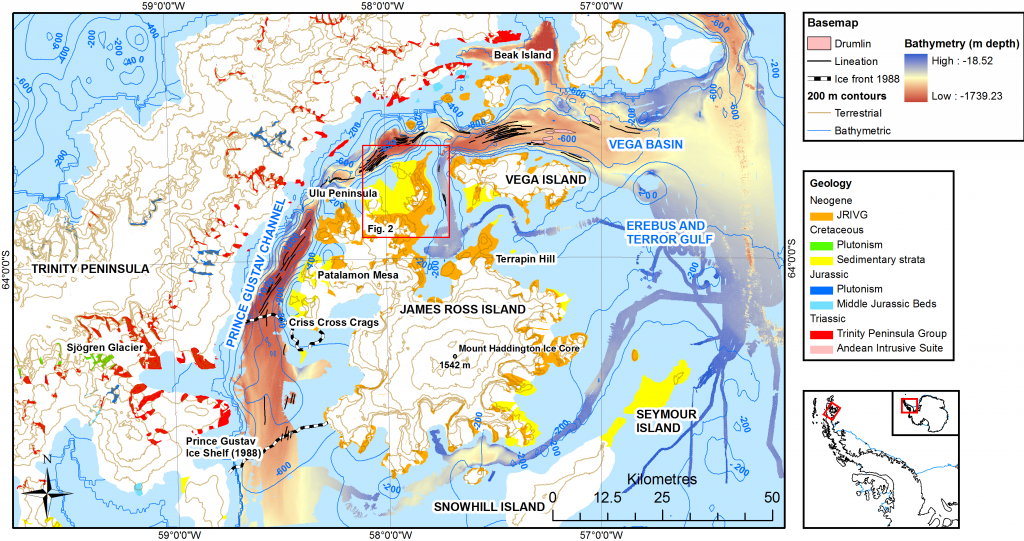
Living on James Ross Island
There is no way around it: if you want to collect high-quality cosmogenic nuclide samples, you have to spend time on the ground. You need to go there, count pebbles to determine sediment transport histories, sketch landforms like moraines, collect samples for particle size analysis, and mark geomorphological features like ridges and breaks in slope in great detail on your map. We were joined by Alan Hill, our mountain safety expert whose job it was to stop the clumsy scientists setting fire to their tent, getting lost in a blizzard or cutting off their foot while sampling a hard granite boulder with a hammer and chisel. We were completely cut off from society, with only a radio link to the main British research station, Rothera, 330 miles to the south by direct flight (which, I hasten to add, wasn’t possible as the ski planes couldn’t land on our rocky ground). We were dropped off, and picked up, by ship. Until our uplift date, some seven weeks hence, we were on our own.
You can use Google Maps to explore James Ross Island for yourself. Ulu Peninsula is the large ice-free peninsula projecting north of the island. If you zoom in on Ulu Peninsula, you will be able to see the flat-topped hills (basalt volcanic floods), with small, cold-based ice domes and small cirque glaciers.
View Larger Map
What did we find?
By sampling granite boulders derived from the nearby mainland Antarctic Peninsula, we were able to reconstruct ice-sheet behaviour through the last glacial cycle. Those granite boulders situated on tops of the ‘mesas’ (a flat-topped hill; that was a hike that day I can tell you!) proved to have been exposed at the Earth’s surface for over 17,700 years. This indicates that the earliest ice-sheet thinning occurred just after the Last Glacial Maximum.
We also found a drift rich in granite erratics around the margins of Prince Gustav Channel. We interpreted this drift, rich in exotic pebbles and boulders, as representing the lateral margins of Prince Gustav Ice Stream, impinging on Ulu Peninsula. Boulders associated with this drift proved to have exposure ages of around 12,000 years in the north to 6,000 years in the south of the study region. One boulder, associated with a lateral moraine from Prince Gustav Ice Stream, had a height of 144 m above sea level and an exposure age of 7,600 years.
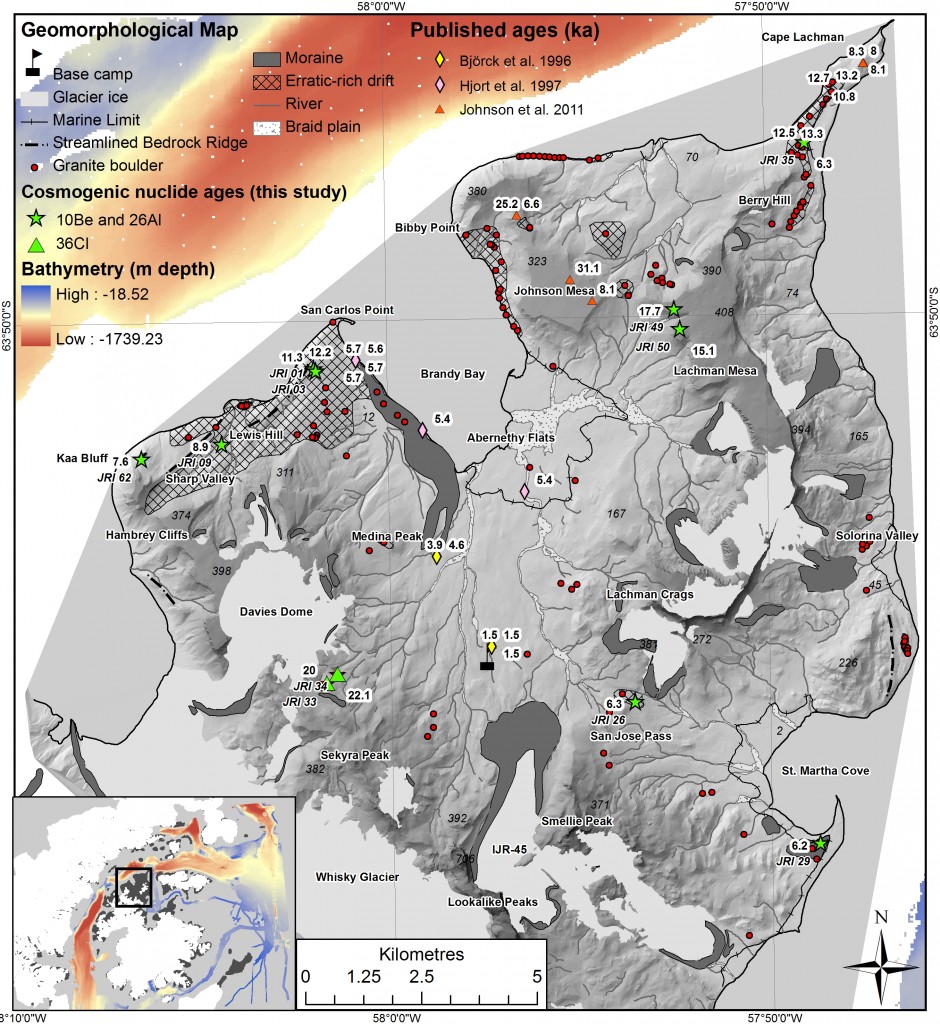
These exposure ages told us that, at the Last Glacial Maximum, Ulu Peninsula was overwhelmed by a large ice sheet that originated on Trinity Peninsula. This thick, colm, slow-moving Antarctic Peninsula Ice Sheet deposited granite boulders all across James Ross Island and on nearby Seymour Island. When it became warmer in the Early Holocene (with temperatures recorded in the Mount Haddington Ice Core, see figure below), the ice sheet began to thin and recede from the continental shelf edge. This surface lowering was coincident with a dynamic change with the onset of Prince Gustav Ice Stream, which occurred after 12,000 years ago but before 18,000 years ago. The ice surface lowered in excess of 230 m during this time. The ice stream continued to impinge on the edges of Ulu Peninsula until 7,000 years ago, after which time it shrank back away from the study area. Local ice from the Mount Haddington Ice Cap remained on the inner parts of Ulu Peninsula until around 6,000 years ago.

Dynamic ice-sheet change
These results indicate that a dynamic change occurred during deglaciation, with the ice sheet switching from a thicker, cold-based style of glaciation at the Last Glacial Maximum to a warm-based, thinner, more dynamic ice sheet with ice streaming and a lower surface profile. This occurred during a period of rapid sea level rise and warming recorded in the Mount Haddington Ice Core. Oxygen isotope data from marine sediments indicate that ice streaming and rapid deglaciation also occurred from 13,000 to 12,000 years ago on the western Antarctic Peninsula, suggesting that ice-stream response was synchronous on both the western and eastern Antarctic Peninsula. This region-wide recession was coincident with increased upwelling of Circumpolar Deep Water onto the continental shelf edge – something we are again seeing around the Antarctic’s marine margins.
The Antarctic Peninsula Ice Sheet is a dynamic environment, sensitive to small changes in oceanic and atmospheric circulation. Our results have important implications for future ice dynamics, as temperatures approach those last seen during the Early Holocene and Mid-Holocene Climatic Optimum – both periods of rapid ice-sheet change. And it’s projected to get even warmer than that.




